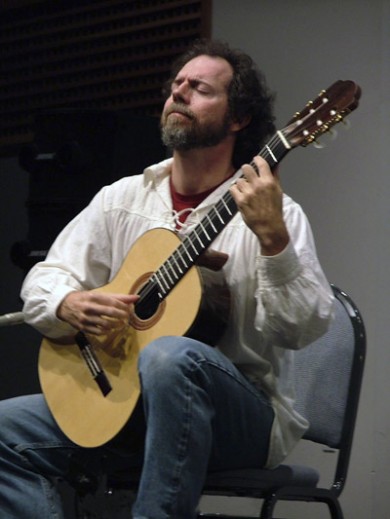York’s guitar music creates an inviting summer idyll in Coral Gables

Composer-guitarist Andrew York performed Thursday night at Coral Gables Congregational Church.
Competing with the Miami Heat’s NBA championship game Thursday night, guitarist Andrew York still managed to pack the pews at Coral Gables Congregational United Church of Christ for the second concert of their 2012 Summer Concert Series.
York’s program consisted mostly of his own compositions from his upcoming CD release Yagmur, with selections from Bach’s Cello Suite No. 5 rounding out the second half.
York’s music is pleasant and accessible, based on classical techniques but informed by pop and jazz idioms. He spoke amiably about his inspiration for each work, putting the lively crowd at ease and in a receptive mood.
Opening with his five-movement suite Glimmerings, York demonstrated a clean technique, enhanced by unobtrusive amplification and the warm acoustics in the Romanesque sanctuary.
The first movement, “Ride,” demonstrated the elements of his style: a well-established bass line or ostinato, agreeable interior harmonies, a ringing melody, and a clear formal structure that doesn’t place too many demands on the listener. The most interesting movements were “Knowing,” a rhythmically inventive madrigal with unusual harmonic shifts, and “Joyn,” beginning with deceptively simple arpeggios but evolving into a rich texture of rapid passagework, hammer-ons and pull-offs, for an affirmative ending.
Three movements of another suite, Woven Harmony, showed a similar design. York’s ideas for the work related to weaving’s warp and weft, with the visible threads accessible and reflecting the beauty of the world, while the invisible threads are more abstract.
This duality was captured in one of the best works of the night, “Warp – Aspect I,” the central movement of this particular grouping. The fireworks were here, with complex rhythms, a ferocious tempo, chromatic hints, and changing meters in a driving moto perpetuo. York’s timbral palette is wide, and his sparkling colors here highlighted the energy of the work, a lovely foil for the two outer movements: “Squares Suspended” and “Woven World.” Each of these simple ternary works featured a dark, rounded tone expanding into a bright contrasting central section and back again.
Most of York’s compositions involve scordatura – a re-tuning of one or more of the guitar’s strings to a different pitch. This adds an edge or mellowness to the overall timbre of his works, but his detuning of the guitar to match a cello’s tuning for the Bach Suite was a risk that didn’t pay off. The relaxed lower strings, although richly dark, had a wiry warble, producing excessive squeaking. The result was a muddy, noisy rendition, lacking the clear voicings and subtle musicality of the rest of York’s program. Much better was York’s encore of Bach’s Minuet in G, which featured tasteful Baroque improvisation on the repeats.
York’s Yagmur and Centerpeace channeled pop and jazz styles, with chordal repetition forming the basis for improvisation on their simple, melancholy melodies. In Yagmur, York sang with his guitar melodies, for a crowd favorite.
The more adventurous, Spanish-influenced Albaycin added percussive effects and harmonics to its ostinato patterns, lending an extra spark to the moody landscape.
York’s closer, Mechanism, with its inspiration of “two little machines that become self-aware and chat with each other,” provided humorous contrast to the rest of the program. A strong opening rock riff, polytonal melodies, a 7/8 bass ostinato in the central section, and sparkling high-register arpeggios over the return of the opening riff brought York’s program to a spirited close.
Posted in Performances
Leave a Comment
Fri Jun 22, 2012
at 1:42 pm
No Comments






